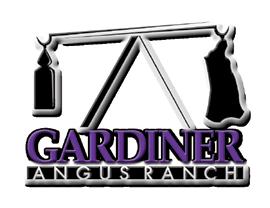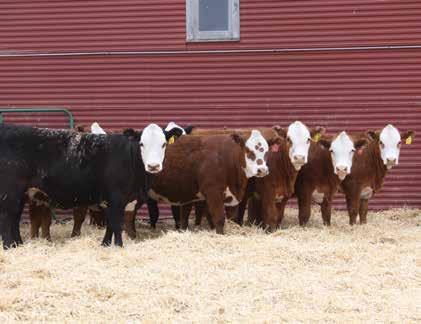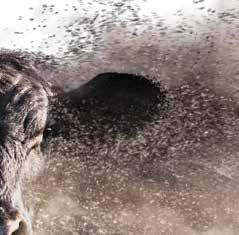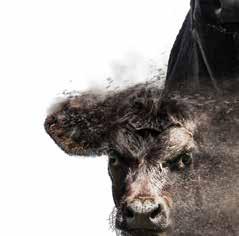
12 minute read
Gone Global
Gone Global U.S. beef export market accounts for a significant and growing portion of cattle value.
Although it can appear straightforward, the economics surrounding U.S. beef exports and imports is complex. Let’s start with this. U.S. export value per head of fed cattle last year was $309.75, according to the U.S. Meat Export Federation (USMEF). That represents roughly 20% of the value of fed cattle. It’s more important to calf prices. By Wes Ishmael
Advertisement
“We’d lose a third of the value of your calves if we lost our export markets,” said Randy Blach of CattleFax, at last fall’s annual Cat Symposium on Excellence in Ranch Management, hosted by the King Ranch Institute for Ranch Management. Arguably, exports represent even more economic impact, given the fact U.S. beef production increased by an average of about 1.5 billion lbs. per year since 1990, according to CattleFax data. At the same time, U.S. consumers have record-large supplies of pork and poultry to choose from.
Although the U.S. is the world’s largest beef producer, largest poultry producer and third largest pork producer, it exports far less beef production than most other countries. For instance, Blach explained Australia exports about
INNOVATION INNOVATION
Visual ID
Electronic ID
Tissue Sampling
Monitoring
72% of its production versus the estimated 12% of U.S. beef production last year, not counting beef variety meats. Imports Add Value to U.S. Beef
U.S. beef imports are where the notion of international trade starts to get sticky for some folks. In simple terms, the argument goes something like this: “Why import beef, which adds to do mestic supply, and all else being equal, should pressure domestic beef prices?” Putting other considerations aside, the fact is that all else is not equal.
“The entire reason for imports and exports comes down to the market seeking the highest value for each product produced and efficient use of resources during the production phase,” explains Andrew P. Griffith, agricultural economist at the University of Tennes see, in a paper from a couple of years ago. “Thus, when one thinks about the beef products demanded by consumers in the United States, it generally comes down to steaks and ground beef. There are domestic consumers who demand round roast, chuck roast, and brisket, but the primary demand is for high quality steaks (Choice and Prime) and ground beef.”
Most beef imported to the U.S. is lean trimmings, used to blend with fatter U.S. beef in order to provide domestic consumers with ground beef of the lean percentages they prefer at affordable prices. Other domestic lean trimmings come from dairy beef.
“Depending on the prices of certain cuts of beef, cuts such as the round and chuck are also ground to meet ground beef demand, but this is a fairly expen sive endeavor considering these whole muscle cuts may have a higher value in the export market,” Griffith explains. Depending on whose abacus you consult, ground beef represents just over half of all beef consumption in the U.S. Fail to provide consumers with the volume demanded, and beef consump tion declines.
Besides, international markets covet some beef products that U.S. consumers care little about.
Think here of things like the short plate, tripe, beef tongue, heart and liver. “For example, short plate could be ground and get about $1.50 per pound here, but because it’s a high demand item in Japan, they will pay double that
41 ST ANNUAL PRODUCTION SALE & CELEBRATION Friday, April 3 & Saturday, April 4, 2020 At the ranch • Near Ashland, Kansas SELLING 1,600 HEAD! 450 Bulls • 900 Registered GAR Females Including the entire Gardiner Angus Ranch registered cow herd! 250 Bred Commercial Females
The Grand Plan 2020 will feature the entire Gardiner Angus Ranch cow herd, INCLUDING ALL 2017 BORN COWS & 2018 BORN HEIFERS. The Grand Plan 2000 featured our entire cow herd. Our goal then was to do the same in the next generation. The Grand Plan 2020 represents the unwavering, uncompromising and disciplined GAR breeding philosophy making it possible for this generational dream to become a reality.
Schedule of Events

Friday, April 3 9 AM: Grand Plan 2020 Bull Sale 11 AM: Lunch available throughout the sale 2 PM: Commercial females sell 5 PM: Dinner served 6 PM: Educational Forum: “Animal Health is Human Health” Megin Nichols, DVM, MPH, DACVPM Saturday, April 4 9 AM: Grand Plan 2020 Registered Female Sale 11 AM: Lunch available throughout the sale
The Grand Plan 2020 offers an extraordinary opportunity for registered and seedstock operations to take advantage of rapid genetic progress into the next half century!
Watch the sale and bid live online at LiveAuctions.tv. Register to bid prior to sale day.

1182 CR Y • Ashland, Kansas 67831 • Office (620) 635-2156 • gar@ucom.net • www.GardinerAngus.com The Henry & Nan Gardiner Family • Mark (620) 635-5095 • Greg (620) 635-0233 • Garth (620) 635-5632 Grant (620) 635-0382 • Cole (620) 635-0727 • Ransom (620) 635-0283
Gelbvieh & Gelfords
Production Sale Saturday, April 4, 2020 1:00 p.m. CST

Sale Broadcast
NEW LOCATION Fairgrounds north end of Canton, KS
replacement heifers • 1st calf heifer pairs Selling... Gelfords and Gelbvieh • 50+ Bulls (18 mo-yearlings) • 5 Show Heifers • 27 Replacement Heifer Pens • Gelbvieh Influenced First Calf Heifer Pairs

Circle S Ranch John & Carla Shearer & Family Canton, Kansas Home 620-628-4621 John Cell 620-654-6507 Johnny Cell 620-654-6731 circle_s@hometelco.net www.circlesgelbvieh.com price per pound,” explains Greg Hanes, CEO of the Cattlemen’s Beef Board, in a recent op-ed. “Assuming each short plate weighs 15 pounds, the United States Meat Export Federation estimates that one item is adding about $22.50 of value per head. Tongues are another great example. Demand (domestic) for those is low, only fetching about $1.00 per pound here in the United States. But in Japan, every person I know loves to grill tongue, so they pay more than $5.50 per pound there. That adds another $13.00 per head.”
In round numbers, based on CattleFax data, Hanes explains the U.S. imported about as much beef last year as it export ed, in terms of volume. In terms of value, though, he emphasizes the value of U.S. beef exports were estimated to be $1.3 billion higher (final 2019 figures will be released in February).
U.S. beef exports last year totaled 1.32 million metric tons (mt), 2.5% below the previous year’s record volume, according to data released by USDA and compiled by USMEF. After increasing by more than $1 billion in 2018, beef export value eased by 3% to $8.1 billion.
Although still strong, softer U.S. beef exports last year magnify the importance of recent progress in trade issues. By the end of last year and the beginning of 2020, the outlook for many of those issues improved. • The Japanese Parliament ratified the trade agreement with the U.S. • The European Parliament approved granting the United States a country-spe cific share of the European Union’s duty-free high quality beef quota. • President Trump signed the U.S.-Mex ico-Canada Agreement, which will replace the North American Free Trade Agreement. • The U.S. and China signed a phaseone trade deal, with China agreeing to purchase and import, on average, at least $40 billion of U.S. food, agricultural and seafood products annually for a total of at least $80 billion over the next two years, according to a fact sheet from the U.S. Trade Representative (USTR). Impor tantly for beef, the deal expands market access with elimination of the 30-month age restriction, acceptance of current U.S. traceability and the ban on U.S. beef from cattle grown with commonly used and safe-proven growth hormones. Before ratification and signing of the latter two agreements, Economic Research Service (ERS) forecasts total beef exports in 2020 to increase about 6% year over year to a record 3.3 billion lbs. At the same time, ERS expects the U.S. to import less beef in 2020. Beef Exports Impact Other Agricultural Value
U.S. corn value would have been $5.7 billion in 2018, if not for U.S. red meat ex ports, according to a study update conducted by World Perspectives, Inc. (WPI) and commissioned by USMEF.
The original 2016 study, “The Intersec
BVD VIRUS TYPE 1B IS ON THE RISE.


Bovine viral diarrhea (BVD) infection can disintegrate herd productivity. And if you’re using a vaccine, like BOVI-SHIELD GOLD®, that isn’t labeled for the most prevalent strain, your cattle could be at risk. Play it safe. Choose the only vaccines specifi cally labeled to protect against Type 1b: Express® FP and Pyramid® + Presponse® SQ. Know more at BVDVTracker.com.


1 Data on fi le, Boehringer Ingelheim and BVDVTracker.com. Data collected November 1, 2018 through November 1, 2019. 2 Ridpath JF, Lovell G, Neill JD, et al. Change in predominance of bovine viral diarrhea virus subgenotypes among samples submitted to a diagnostic laboratory over a 20-year time span. J Vet Diagn Invest 2011;23(2):185–193.
EXPRESS®, PYRAMID® and PRESPONSE® are registered trademarks of Boehringer Ingelheim Animal Health USA Inc. All other trademarks are property of their respective owners. ©2019 Boehringer Ingelheim Animal Health USA Inc., Duluth, GA. All Rights Reserved. US-BOV-0283-2019A

tion of U.S. Meat Exports and Domestic Corn Use,” also conducted by WPI, concluded U.S. red meat exports in 2015 accounted for 11.7 million tons of com bined corn and dried distillers grains with solubles (DDGS) use. According to the 2018 update, exports accounted for 14.9 million tons of corn and DDGS. “Growing global meat consump tion is the major driver for increasing production and expanding trade for nu merous commodities, including coarse grains, oilseeds, and livestock and meat products,” according to U.S. Agricultural Projections to 2028, from the World Agricultural Outlook Board (WAOB). U.S. Represents Sliver of Global Population
The global population is about 7.8 billion people. The U.S. population represents about 4% of that at around 329 million.
“Global per capita meat consumption remains low compared with levels in higher income countries—an indication of the potential for continued growth in world meat consumption,” according to the WAOB report. “Over the projection period, global meat (beef, pork and poultry) consumption increases by 47.9 million tons (15%), which increases trade by 7.9 million tons (25%)… The five countries accounting for the largest share of increased meat consumption over the projection period are China (23.5%), the United States (6.7%), India (6.3%), Brazil (6.2%) and Mexico (4.9%). The United States has a low growth rate in consumption, but a large population and already has a large per capita disappear ance of meats.”
In other words, growing the U.S. cattle and beef industries will come through increased international demand.
Besides more potential customers and coveting some beef parts more than U.S. consumers, international consumers also cleave different paths to increased beef consumption.
Consider the growing trend of meat and meat snack purchases at conve nience stores around the world.
Convenience stores are offering a wide selection of entrée and full meal options that are winning customers and creating more demand for U.S. red meat, according to USMEF. For every gourmet hot dog sold in a South Korean GS25 store, every bowl of beef noodle soup ladled from a 7-Eleven hot food counter in Taiwan and every pork sausage sandwich pulled from a shelf in a Mexican Oxxo outlet comes another trade opportunity for the U.S. beef and pork industries.
According to a 2019 report by Euromonitor, which tracks retail sales and maintains a category dedicated specifically to convenience stores, per capita spending on foodservice products at convenience stores increased 14% worldwide between 2013 and 2018 and is projected to increase another 11% by 2023. South Korea leads the way, with a 142% increase in per capita convenience store foodservice spending from 2013 to 2018; another 47% increase projected by 2023.
“Just as important as promoting existing products, we are developing brand new ideas for packaged meals and protein snack items featuring U.S. beef and pork that fit well with consum er trends in each individual market,” explains USMEF President and CEO Dan Halstrom. “USMEF recognizes the scope of this opportunity and the enor mous demand that is driving it. As the convenience store sector has taken off in various parts of the world, suppliers realize they need products to help meet the demand for these meat snacks and packaged meals. The trend is toward high quality meat, and that is definitely an advantage for U.S. beef and pork.” Japan, Taiwan, the ASEAN region and Mexico are other fast growing mar kets identified by Euromonitor, while a USDA report suggests China’s conve nience store chains, which have historically focused on lower priced processed foods, are beginning to expand premium and imported food offerings. This trend is likely to continue as younger Chinese consumers shift away from traditional retail outlets.
“Obviously there is tremendous potential for U.S. beef and pork in the convenience store sector, but competi tion is intense, so we must focus our efforts on identifying ways to highlight the advantages of U.S. products,” Halstrom says. “The quality and consistency that U.S. beef and pork deliver in processed products are really what set us apart.”
Editor’s message continued
Continued from page 3 _____________________________________ debate with my city friends. After all, they are our customers. I can explain the difference in beef quality and what to shop for to ensure a better eating experience. At 30,000 feet, I can explain the complexities of getting safe, healthy and nutrient dense beef to their favorite supermarket. I can explain the long-term consequenc es of some far-left policies they may be in favor of that will jeop ardize food security everywhere. The greatest lesson learned is that I shouldn’t quit my day job!
69%


2019 1
61%
2008 2
54%
1998 2
41%

1988 2
Percent of all BVDV cases attributed to TYPE 1B.




RELENTLESS PROTECTION





